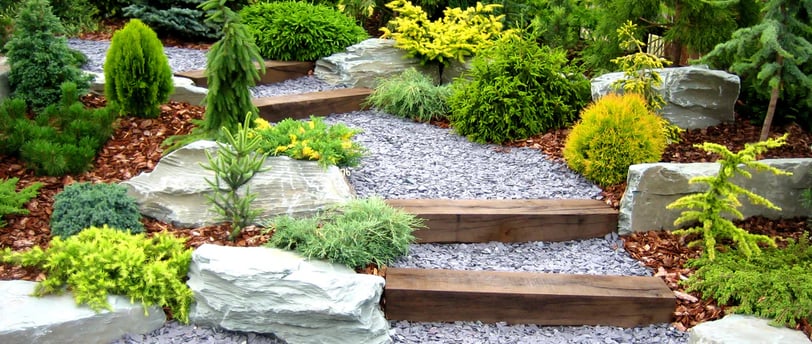Outdoor Flooring Options: Stepping Stones & Pathways
Explore popular outdoor flooring options like stepping stones and pathways. Discover their aesthetic appeal and practical benefits for enhancing your outdoor spaces.
5/20/20255 min read


Understanding Flooring Options: The Benefits of Stepping Stones and Pathways
When considering flooring options for outdoor spaces, stepping stones and pathways have emerged as popular choices due to their aesthetic appeal and practical benefits. Stepping stones can enhance the visual aspect of a garden or landscape, creating a cohesive design that complements the surrounding elements. These stones serve not only as functional walkways but also as decorative accents that can add character and charm to residential and commercial properties alike.
One of the key advantages of utilizing stepping stones in landscaping is their durability. Made from various materials such as natural stone, concrete, or composite materials, stepping stones offer resilience against weathering, making them suitable for all climates. Unlike traditional paver stones, which often require extensive installation processes, stepping stones provide a more straightforward approach. They can be placed directly on soil, gravel, or sand, facilitating a quicker installation which appeals to both DIY enthusiasts and landscaping professionals.
Maintenance is another vital consideration when selecting flooring options. Stepping stones typically require less upkeep compared to their paver counterparts. They can be easily cleaned with a hose or pressure washer, and their positioning allows for natural drainage, minimizing the risk of water pooling. This practical benefit makes stepping stones a favorable option for busy homeowners or facility managers looking to maintain an appealing outdoor environment with minimal effort.
When selecting stepping stones, it is essential to consider the materials and design that will best suit the intended space. Options vary widely, from sleek modern designs to rustic natural stones, catering to different aesthetic preferences. Additionally, integrating pathways that flow naturally through the landscape can further enhance the overall design, creating a harmonious blend of function and beauty. As you contemplate flooring for your outdoor areas, stepping stones present a versatile, durable, and visually appealing solution to elevate your landscape.
Natural Grass Maintenance: Fixing and Removing Grass for Optimal Landscapes
Maintaining a lush and vibrant natural grass lawn is essential for enhancing any landscape. Over time, natural grass can suffer from various issues, such as pest infestations, diseases, and unfavorable environmental conditions. Identifying the problems early on is crucial for effective maintenance. Common signs of unhealthy grass include discoloration, patchy areas, or the presence of weeds. Understanding the underlying causes can aid in determining the appropriate maintenance strategy.
To address patchy areas, the first step is to assess the damage. If sections of grass are simply thin or discolored but still alive, overseeding might be an effective solution. This involves spreading seeds over the existing grass to promote growth in bare spots. Choosing the right type of grass seed, compatible with your local climate, ensures successful germination. Timing is also critical; early spring or fall are generally the best seasons for overseeding, as the temperatures support optimal growth.
In cases where grass is beyond repair due to extensive damage from pests or disease, removal may be necessary. Start by using a spade or sod cutter to remove the affected sections, taking care to also eliminate any underlying roots to prevent re-growth. After removal, soil treatment is essential. Testing the soil can help in understanding nutrient deficiencies and can guide you in amending it with organic matter or fertilizers to prepare for new grass.
Once the soil is ready, reseeding can commence. Again, spring or fall is ideal for establishing new growth. Regular maintenance practices such as proper watering, fertilizing, and pest control will be vital in ensuring that your natural grass thrives. By understanding the intricacies of grass maintenance, homeowners can rejuvenate their lawns effectively, creating an appealing outdoor space for family and guests alike.
Hotel and Apartment Maintenance: Ensuring Beautiful Outdoor Spaces
Maintaining outdoor spaces in hotels and apartments is crucial for enhancing the experience of guests and residents alike. These areas serve as extensions of the living environment and contribute significantly to the overall aesthetic appeal of the property. Regular inspections should be an integral part of a maintenance schedule to ensure that the landscaping remains pristine and inviting. This not only involves checking for any damaged plants or hardscaping but also ensuring that pathways and seating areas are safe and well-kept.
A well-planned landscape can transform ordinary outdoor areas into stunning spectacles, which in turn attracts potential guests and increases resident satisfaction. Incorporating a variety of plants, flowers, and recreational spaces can enhance the visual charm and functionality of these areas. To achieve this, it is beneficial to develop a routine that includes seasonal plantings, lawn care, and seasonal clean-ups. Investing in skilled landscaping contractors can also yield long-term benefits, as they provide specialized knowledge and ensure that the maintenance is performed to professional standards.
Sustainability practices are becoming increasingly important in landscaping maintenance. Implementing eco-friendly techniques such as xeriscaping, which minimizes water usage, and using native plants that require less care can reduce costs and environmental impact. These practices not only enhance the look of the outdoor spaces but also resonate positively with environmentally conscious guests and residents.
Finally, involving residents in the maintenance process can lead to continuous improvement of outdoor areas. Gathering feedback through surveys or informal discussions allows property managers to understand the needs and desires of those who use the spaces. By prioritizing these insights, properties can ensure their landscapes remain functional, attractive, and tailored to the community they serve.
Artificial Grass Solutions: Installation, Fixing, and Supply Considerations
Artificial grass has gained significant traction in recent years, primarily due to its low maintenance requirements and aesthetic appeal compared to natural grass. This synthetic option offers numerous benefits, such as water conservation, resilience to varying weather conditions, and the elimination of the need for pesticides or fertilizers. Its ability to remain green and inviting throughout the year also makes it an attractive choice for both residential and commercial spaces.
When considering the installation of artificial grass, several techniques can ensure optimum results. A well-prepared base is crucial; this typically involves excavating the existing soil, placing a geotextile membrane to prevent weed growth, and adding a layer of crushed stone to facilitate drainage. Once the base is set, the synthetic grass is rolled out and secured to prevent any shifting or wrinkling. Seam tape can be utilized to join pieces of grass seamlessly, creating a uniform look across larger areas.
However, artificial grass is not entirely maintenance-free. Over time, wear and tear may occur, especially in high-traffic areas. Regular cleaning, which can involve brushing the fibers and rinsing with water, helps maintain its appearance and hygiene. Additionally, addressing any damages promptly is essential. Issues such as discoloration, tears, or movement can often be repaired by sourcing patches from the original installation supplier. Knowing how to fix these common challenges will prolong the lifespan of your synthetic turf.
Choosing the right supplier is key to ensuring quality in artificial grass products. Prospective buyers should look for suppliers that offer warranties, high-quality materials, and a variety of styles that can match different landscape needs. Moreover, researching case studies of successful installations can provide valuable insights into the practical benefits and potential challenges of artificial grass, inspiring informed decisions for your landscaping projects.
